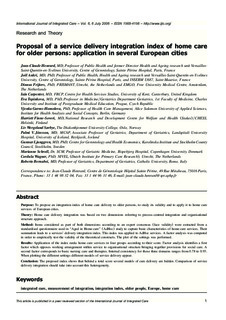| dc.contributor.author | Henrard, Jean-Claude | |
| dc.contributor.author | Ankri, Joël | |
| dc.contributor.author | Frijters, Dinnus | |
| dc.contributor.author | Carpenter, Iain | |
| dc.contributor.author | Topinkova, Eva | |
| dc.contributor.author | Garms-Homolova, Vjenka | |
| dc.contributor.author | Finne-Soveri, Harriet[t] | |
| dc.contributor.author | Sørbye, Liv Wergeland | |
| dc.contributor.author | Jónsson, Pálmi V. | |
| dc.contributor.author | Ljunggren, Gunnar | |
| dc.contributor.author | Schroll, Marianne | |
| dc.contributor.author | Wagner, Cordula | |
| dc.contributor.author | Bernabei, Roberto | |
| dc.date.accessioned | 2007-06-12T12:03:21Z | |
| dc.date.issued | 2006-07 | |
| dc.identifier.issn | 1568-4156 | |
| dc.identifier.uri | http://hdl.handle.net/11250/98849 | |
| dc.description.abstract | Purpose: To propose an integration index of home care delivery to older persons, to study its validity and to apply it to home care services of European cities.
Theory: Home care delivery integration was based on two dimensions referring to process-centred integration and organisational structure approach.
Method: Items considered as part of both dimensions according to an expert consensus (face validity) were extracted from a standardised questionnaire used in ‘‘Aged in Home care’’ (AdHoc) study to capture basic characteristics of home care services. Their summation leads to a services’ delivery integration index. This index was applied to AdHoc services. A factor analysis was computed in order to empirically test the validity of the theoretical constructs. The plot of the settings was performed.
Results: Application of the index ranks home care services in four groups according to their score. Factor analysis identifies a first factor which opposes working arrangement within service to organisational structure bringing together provisions for social care. A second factor corresponds to basic nursing care and therapies. Internal consistency for those three domains ranges from 0.78 to 0.93. When plotting the different settings different models of service delivery appear.
Conclusion: The proposed index shows that behind a total score several models of care delivery are hidden. Comparison of service delivery integration should take into account this heterogeneity. | en |
| dc.format.extent | 551977 bytes | |
| dc.format.mimetype | application/pdf | |
| dc.language.iso | eng | en |
| dc.publisher | University of Utrecht | en |
| dc.subject | Europa | en |
| dc.subject | hjemmetjenester | en |
| dc.subject | hjemmesykepleie | en |
| dc.subject | eldre | en |
| dc.subject | integrated care | en |
| dc.subject | measurement of integration | en |
| dc.subject | integration index | en |
| dc.subject | older people | en |
| dc.subject | Europe | en |
| dc.subject | home care | en |
| dc.subject | vitenskapelig (fagfellevurdert) | |
| dc.title | Proposal of a service delivery integration index of home care for older persons : application in several European cities | en |
| dc.type | Journal article | en |
| dc.type | Peer reviewed | |
| dc.source.pagenumber | [9 s.] | en |
| dc.source.volume | 6 | en |
| dc.source.journal | International Journal of Integrated Care | en |
| dc.source.issue | [kun elektronisk, full referanse: Int J Integr Care. 2006 Jul–Sep; 6: e11. ] | en |
